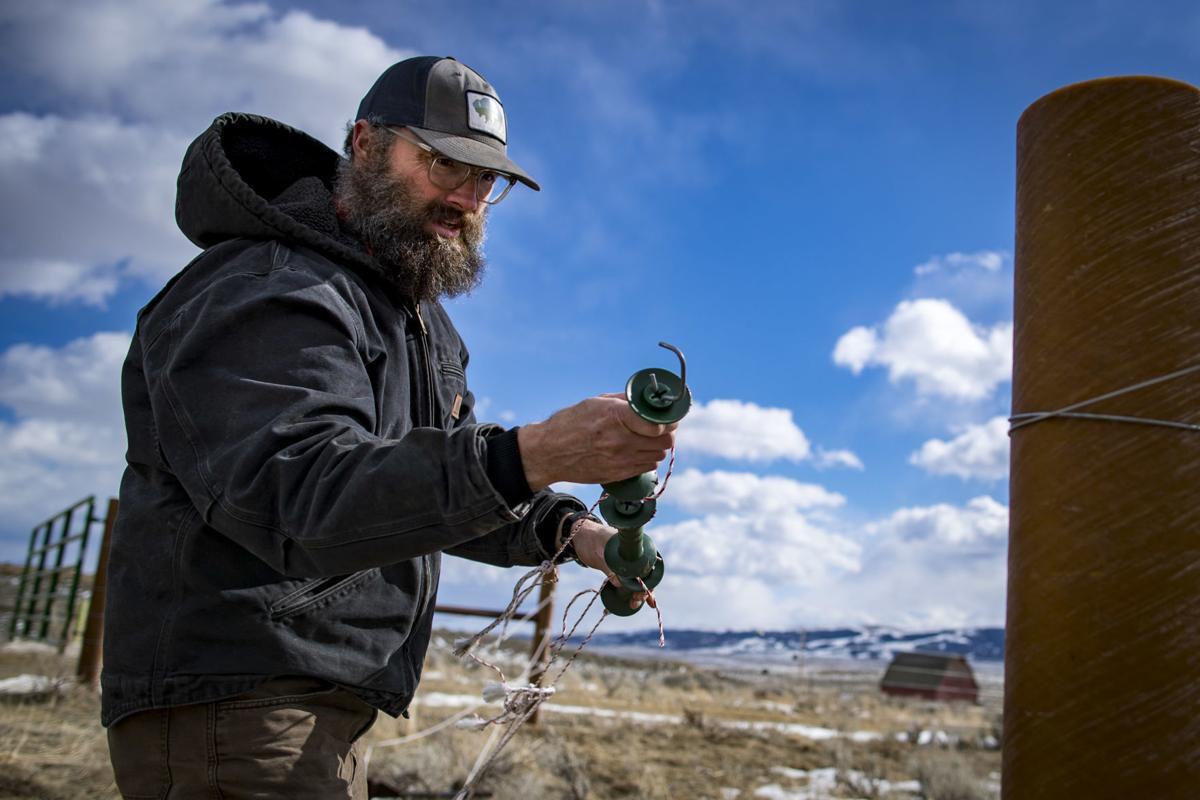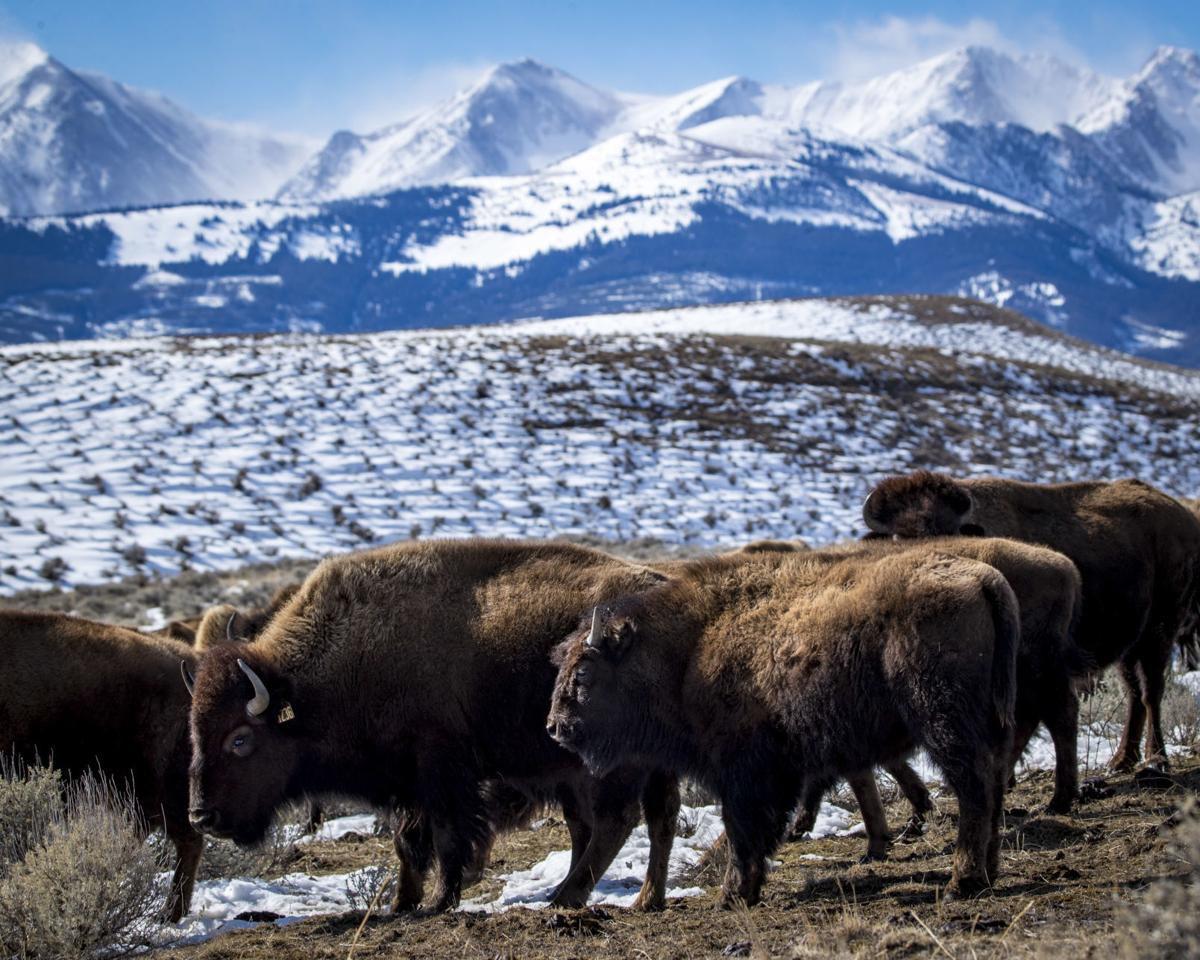
Matt Skoglund’s rubber boots are shredded. A previous attempt at holding the rips together with sealant is now yellowed and peeling. Blood is smeared across the rear door handle of his white flatbed pickup. Inside the truck cab, on the floor, rests a small tangle of curly brown bison hair.
Born and raised in suburban Chicago, Matt seems an unlikely candidate for the role of bison rancher, but at the age of 41 the one-time lawyer and former Bozeman environmental group director has fully embraced his new career in all of its glory and messiness.
“I craved doing something on my own and more tangible that was rooted here in southwest Montana, that would have a conservation ethos to it but entrepreneurial — a business, not a nonprofit,” he said, a wide smile spreading amid his bushy, gray-streaked beard. “I’m trying to make the world a better place.”
So in 2018, after a year of intense research, he overcame his “giant insecurity” about knowing nothing about ranching and leapt into the lifestyle head-first. In the process he also took out a second mortgage on his home, borrowed money from his retirement plan and obtained bank loans. The money financed the purchase of land on the east side of the Bridger Mountains and the bison to graze it.
“The funny thing is, I don’t know why, but it hasn’t been scary,” said Sarah Skoglund, Matt’s wife. “It’s always felt like it’s been too right to be scary.”
The debt seems like an investment in a new lifestyle, she added, something much more philosophical than just land and bison.
“To worry about it and not do it seemed like a bigger risk,” Sarah said.
Raised in Chicago, Sarah admitted that her sense of ease with the transition to rancher’s wife at age 40 while raising two youngsters may also be born out of innocence.
“It’s probably because I have no idea of what to be scared of,” she said half-jokingly. “I’m probably so naïve it’s benefiting me.”
The bison ranch, christened North Bridger Bison, is about 10 miles west of the small ranching community of Wilsall in the Shields River Valley. The 770 acres the Skoglunds purchased is huddled along the Middle Fork of Dry Creek. The creek and nearby ponds are bright oases of green in the sagebrush hills.
“We literally do not have a tree,” Matt said. “It’s all grass and sagebrush, but we have amazing water.”
The ranch also has a spectacular panoramic view, with the Crazy Mountains jutting above the prairie to the east and the wind-whipped peaks of the snowy Bridger Mountains close to the west.
The 150 head of bison now roaming a portion of the ranch seem unconcerned by the 60 mph wind gusts that rocked Matt as he recently stood atop an overlooking hill. Purchased from a bison ranch near Choteau last year, the genetically pure animals — with no cattle genes — hold the key to his young family’s future.
“It’s all about keeping the costs down,” he said, which means he does much of the labor.
“It’s very capital intensive up front, but in three years, hopefully, it really starts to work.”
North Bridger Bison is a field to table organization. Once an order is filled for a whole bison — which sells for $750 a quarter — Matt will drive into the pasture, steady his .308 rifle on the truck’s rearview mirror brace, and squeeze off a shot aimed at a bison’s ear. The 160 grain copper bullets have always proved fatal, collapsing the targeted animal in its tracks.
The rest of the herd’s reaction to the killings has been mixed. Some are curious, others show aggression by hooking the dead bison with their horns. Sometimes there’s no reaction at all, in other instances bison will follow the truck in a funeral-like procession as their dead companion is hauled away.
“Until we can speak bison, we’re just guessing” what they are thinking, Matt said, but overall they seemed unfazed and soon return to grazing.
Using a hay bale mover attached to his truck bed, he hauls the dead bison to a nearby field and guts it out. Within about an hour he’s hauling the carcass to a meat processer in the Gallatin Valley where it is skinned, halved and hung to age for about 10 days.
Bill Jones, of the Amsterdam Meat Shop, said his five-person crew can cut the animal up in about three hours. Then the meat is wrapped and frozen. Although bison butchering isn’t a large part of Jones’ business, he said it has been important. Other ranches that he’s cut bison meat for has sold to customers from Alaska to Ohio.
North Bridger Bison sells its animals for about $16 a pound. A quarter of a bison adds up to about 90-pounds of packaged meat. Included with the shipment is a patch of the bison’s hair and a sprig of the ranch’s sagebrush. Since last spring the company has sold about 23 bison.
“I feel really great about the process,” Matt said.
By field harvesting the animal he said the bison feels no stress before dying. The gut pile is cleaned up by scavengers in less than a week. Dry aging the carcass increases the meat’s tenderness. Only bison fat is added to the hamburger.
“We eat so much bison I joke that my kids are going to grow horns,” he said.
The Skoglunds aren’t alone in their attachment to bison ranching. The National Bison Association touts 1,100 members, according to Karen Conley, communications director for the Colorado-based group. Members range from people with five head of bison to large-scale producers with herds of 3,000, she said. Members are located in all 50 states, Canada and overseas.
Montana is best known for large private bison herds found on Ted Turner’s ranches and the nonprofit American Prairie Reserve, as well as those owned by the Blackfeet, Assiniboine, Sioux and Crow tribes.
As of 2017, the U.S. Department of Agriculture counted 80 bison farms in Montana with about 19,100 animals. That was up from the 2012 Census when bison numbered about 14,600.
Laurie Demeritt, CEO of The Hartman Group, which tracks trends in the food industry, said there is a market for bison meat even at premium prices.
“Bison is in that sweet spot between wellness and sustainable farming,” she said. “If anything, some of those claims about taking better care of the animals and the land” will make it a more attractive product. She said consumers are rethinking protein sources, which are more varied now than ever before, including those made in the laboratory.
Although the Shields Valley is a traditional cattle ranching area, the Skoglunds’ neighbors have been accepting of the bison venture, as well as helpful. One neighbor loaned Matt the use of a truck after his caught fire.
“I’ve been extremely transparent and honest with them, and very humble,” Matt said. “One of the most rewarding and coolest parts of this is the relationships we’ve established with our neighbors.”
Matt said when he initially introduced himself to those he shared fences with, and told them that he planned to raise bison, there was a pregnant pause. He compared it to the old western movie scene where the stranger enters the saloon and the piano player stops, everyone quits talking and stares. By answering their questions, however, he was able to demystify the process. To some neighbors he’s now referred to as “buffalo guy.”
Bill Palmer grew up in the Shields Valley, has land bordering the Skoglunds and used to own part of their property. When Matt told his neighbor he planned to raise bison next door, Palmer was surprised. He said it’s not unusual to see rural land buyers looking for a new lifestyle, “but I feel sorry for people like that in a way,” he added. “They don’t know what they are getting into.”
The fact that the Skoglunds would be raising bison instead of cattle was no concern to Palmer, although some agricultural counties have taken a staunch anti-bison stance.
“I don’t really have any concern about it,” Palmer said. “It looks to me like they take pretty good care of them.”
He added that it’s “kind of nice” to see bison on the landscape, but the animals don’t seem to make much sense from a practical standpoint.
“They’re just a poor quality cow,” Palmer said.
Hauling hay, fixing fence and moving bison from pasture to pasture on a rotational grazing system is a long way from Matt’s days of advocating for wildlife at the Natural Resources Defense Council. That job meant long meetings with federal and state officials, trips out of state and lots of time on the computer, or in an office. As he discussed solutions to complicated wildlife problems with state and federal officials they sometimes would agree that a proposal may have merit but that it would never fly due to politics.
“Over time you feel like you’re banging your head against the wall,” he said.
Now every two days or so, Matt commutes about a half-hour from his downtown Bozeman home, cruising past the crowded slopes of Bridger Bowl Ski Area and Crosscut Mountain Sports Center’s sleek Nordic skiers to reach the North Bridger Bison ranch. Riding shotgun is Aldo, his 11-year-old black Labrador. Chores have to be wrapped up before 3 p.m. on a recent Wednesday so Skoglund can hurry back to Bozeman and pick up his 6-year-old son from school.
It’s a hectic, unruly routine he loves, and a lifestyle he never imagined growing up in suburban Chicago or while working in a large law firm. But since moving to Montana he’s fully embraced being a meat hunter, gardener and morel mushroom “nut.”
“We were suffocating in the city,” Sarah said. “We wanted to be outdoors and more active.”
So after making a visit to Bozeman, getting married and going on a honeymoon the new couple packed up a moving van and drove out West to start a new life 12 years ago.
“We really wanted the adventure,” Sarah said. “Be careful what you wish for.”
Matt’s other trip from Googling “bison ranching” in June of 2018 to attending workshops and finally pulling the trigger on buying property seems fast. By December 2019 the bison had arrived and at the end of April North Bridger Bison was open for business.
In the span of a year Matt has gone from being knee deep in environmental analyses and meetings to talking about soil, flushing sage grouse on winter walks and watching pronghorn mosey past land his family will one day own free and clear. On the flip side he’s been repeatedly shocked by the electric fence that surrounds his herd and stuck his truck in every soft spot on the ranch. To say it has been a learning experience seems an understatement.
“I had a giant insecurity about not knowing anything about ranching,” he said. “I thought if you didn’t grow up ranching how do you run a ranch?”
The answer, it turns out, is multifaceted: a lot of help from those in the know, a willingness of friends and neighbors to lend a hand, a patient and understanding wife and an eagerness to learn.
“It’s been one heck of an adventure.”
2020-03-21 17:43:00Z
https://trib.com/news/state-and-regional/buffalo-jump-chicago-natives-leap-into-new-lifestyle-as-bison/article_195f8b46-75db-5c83-bd51-dd193f891584.html
Bagikan Berita Ini


















0 Response to "Buffalo jump: Chicago natives leap into new lifestyle as bison ranchers - Casper Star-Tribune Online"
Post a Comment